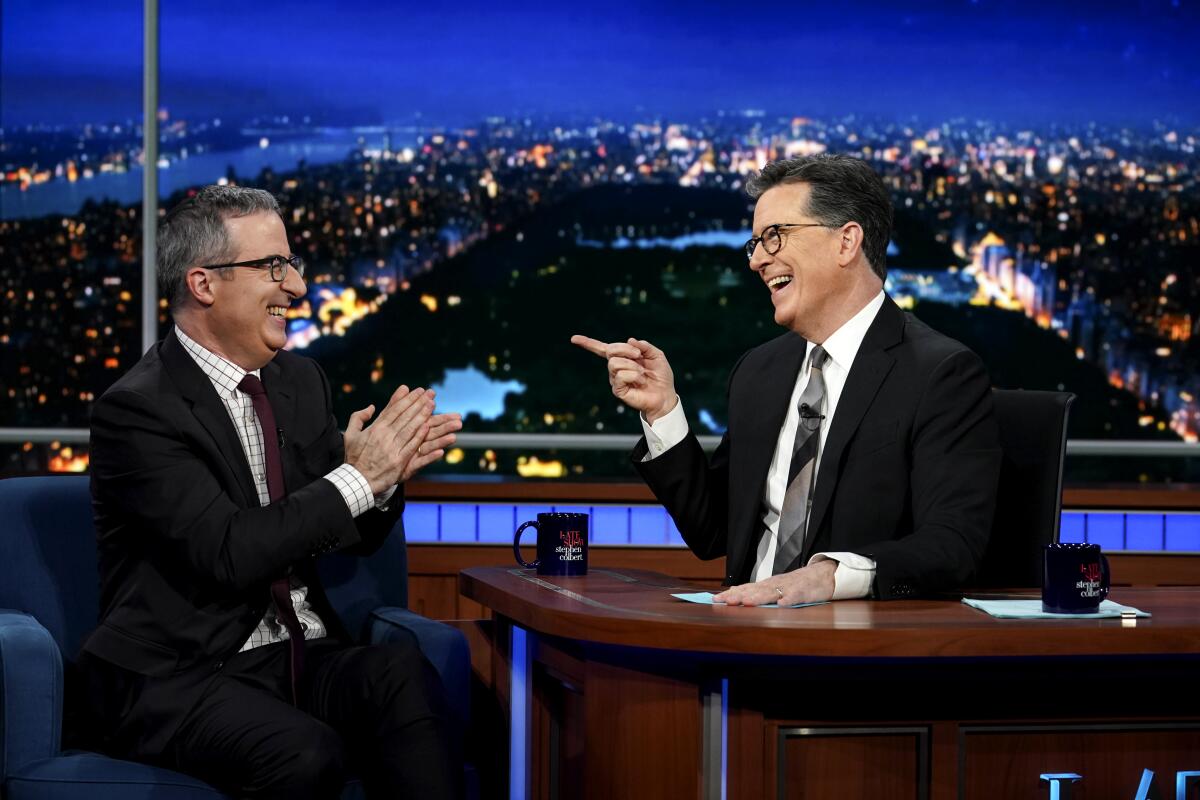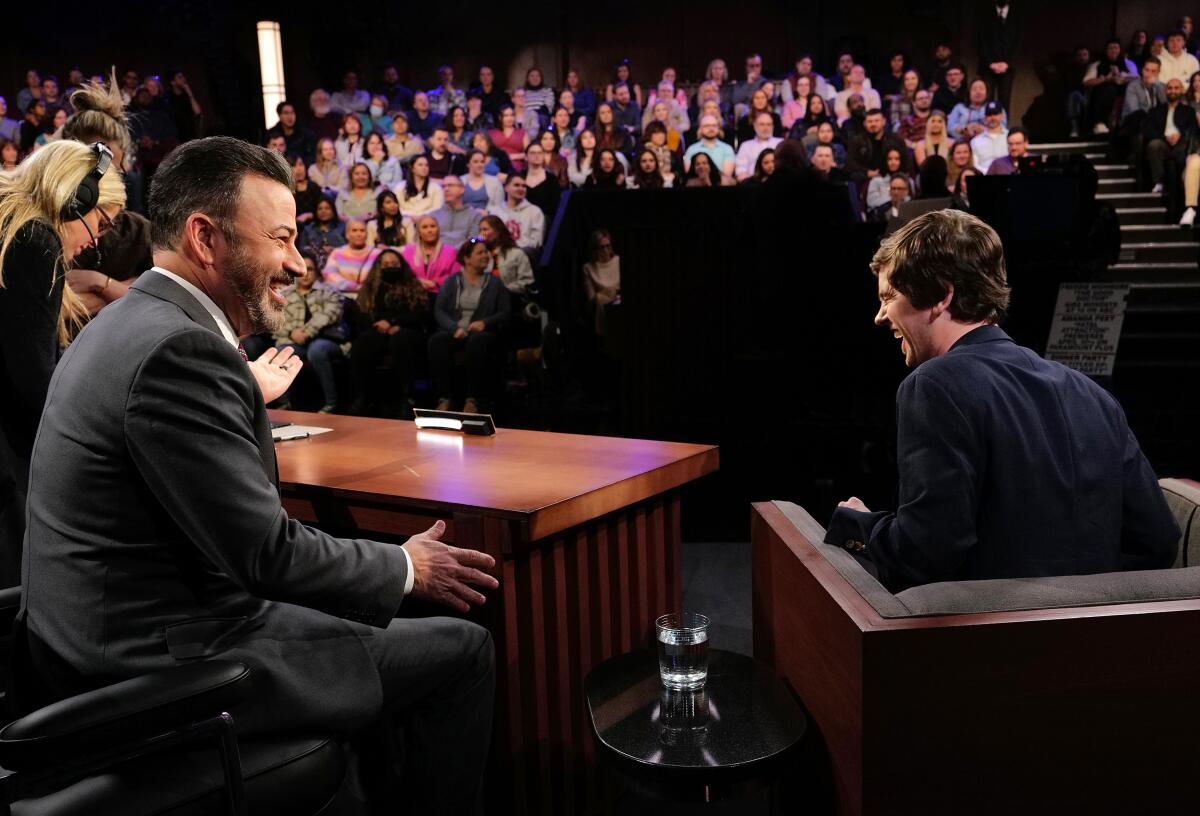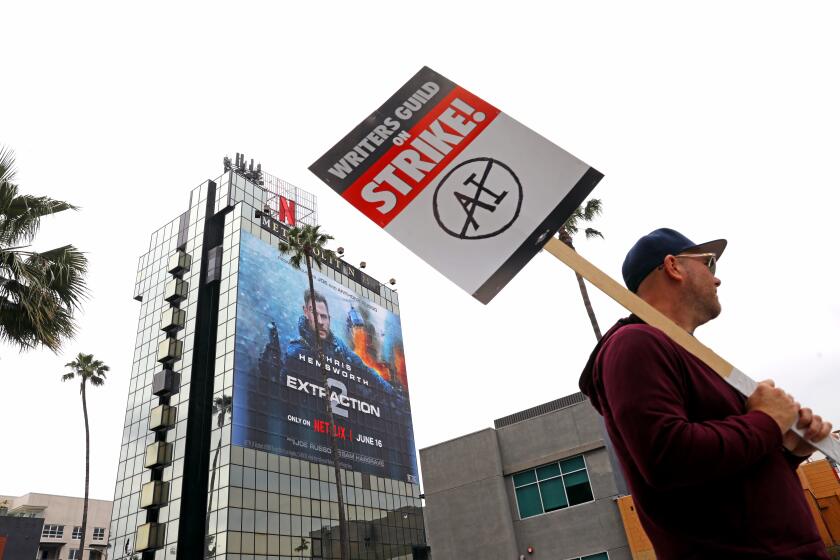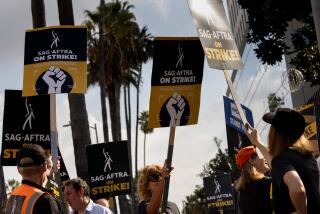Now that writers can work again, here’s when daytime and late-night talk shows will return

- Share via
Your favorite late-night hosts will soon be getting back into the national conversation.
The resolution of the Writers Guild of America strike, which officially ended at midnight Wednesday, means NBC’s “The Tonight Show Starring Jimmy Fallon” and “Late Night With Seth Meyers,” CBS’ “The Late Show With Stephen Colbert” and ABC’s “Jimmy Kimmel Live!” — as well as HBO’s “Last Week Tonight With John Oliver” — are heading back into production next week and will be among the first entertainment programs back on the air since the work stoppage began.
On Wednesday morning, Kimmel, Colbert, Fallon, Meyers and Oliver — who launched a podcast called “Strike Force Five” to raise money for out-of-work crew members during the labor dispute — said they would return to TV beginning Sunday, when a new episode of “Last Week Tonight” will air on HBO. The four broadcast network hosts will be back on the air Monday night, exactly five months after their shows went dark.
They will follow “Real Time With Bill Maher,” which returns to HBO on Friday. Maher made the announcement on social media shortly after the WGA board voted to formally call off the strike Tuesday evening. Meanwhile, “The Daily Show” is scheduled to return to Comedy Central on Oct. 16 with a roster of guest hosts filling in for the remainder of the year. Trevor Noah, who took over the desk from Jon Stewart in 2015, stepped down from the job in late 2022. A permanent replacement is expected in 2024, according to the network.
Daytime talk shows are also expected to resume production in the coming days. There are reports that Drew Barrymore’s daytime program, which depends on WGA writers, will be back up and running next month as well, though no date has been specified. Similarly for “The Kelly Clarkson Show,” no return date has been set. However, “The Jennifer Hudson Show” announced that it will have new episodes starting Monday and CBS would like its daytime chat-fest “The Talk” to restart by Oct. 9, if not sooner.
Key takeaways from the tentative contract that would end the writers’ strike, and how it addresses writers room staffing, streaming residuals and artificial intelligence.
The late-night talk shows on broadcast and cable networks went dark as soon as the WGA went on strike May 2. (A tentative agreement with the Alliance of Motion Picture and Television Producers was reached Sunday night, giving the union’s members improved residuals for streaming and protections regarding the use of AI. Though the board has approved the agreement, and the strike will be lifted, members of the guild still need to vote to ratify the agreement.)

These shows rely heavily on writers who craft the nightly monologue and other comedic routines — often riffing on topics in the news that day. Scripts are written hours or minutes — rather than days or weeks — before the cameras start rolling. But because the productions are so nimble, they’re also expected to be the first back on the air once writers are given the OK to return to work.
Unlike on a scripted drama such as “Stranger Things,” resuming production on a talk show is fairly simple. Most shows are taped in studios and theaters that have been sitting idle for months. As proved during the early days of the pandemic — when Seth Meyers emceed “Late Night” from his attic and Stephen Colbert hosted “The Late Show” from his home office — all you really need to make late-night TV is a host, a camera and a script.
Even contracts that win over the most skeptical writers and actors won’t be able to fix some of the biggest fractures facing the industry today.
And even though SAG-AFTRA remains on strike — hobbling production on countless scripted dramas and sitcoms — Colbert, Fallon and other late-night hosts are free to resume their performing duties because daily late-night shows are covered under a separate deal with the union, known as the Network Television Code.
But navigating the road back to pre-strike normalcy won’t be simple.
With actors still on strike and largely barred from promoting their film and TV projects, the most difficult task for producers may be booking talent to fill the guest slots. Then again, there should be plenty of musicians, directors, authors and reality stars eager to fill the void.

While the programs might suffer a shortage of marquee guests, they should have no trouble filling time with riffs from their hosts, whose monologues and commentary are a part of the cultural zeitgeist. Their need may border on addiction, as the four network hosts and HBO’s Oliver teamed up for the 12-episode Spotify podcast “Strike Force Five,” which afforded them opportunity to riff. They gave revenue generated by the project to unemployed staff members affected by the strike.
“I think the pain for the hosts has been that when somebody does something extraordinarily stupid, they’re forced to bite their tongues and sit on it,” said Daniel Kellison, a former executive producer of “Jimmy Kimmel Live!” “Everyone’s going to be very eager to be back.”
The backlash during the WGA strike to Barrymore and others who tried to return to work before there was a resolution means all of the returning shows will have to be cautious that they respect SAG-AFTRA members if they are not back to work soon.
On Sept. 10, the actor-turned-daytime host announced she would resume production of her syndicated talk show, which had been on a scheduled hiatus since the spring, even though it employs writers who are guild members. The news led to picket lines outside the show’s studio in Manhattan and triggered massive backlash on social media. After doubling down on the decision with a disastrous video she later deleted, Barrymore eventually backtracked, saying “The Drew Barrymore Show” would not return until the strike was resolved.
Spurred by a PR crisis, the decision became a watershed moment in the strike: Other talk shows that had planned to resume production without writers, including “Real Time With Bill Maher” and “The Talk,” also decided to wait until the strike was resolved. Within days, the guild and the AMPTP were back at the bargaining table, working out an agreement.
More to Read
Inside the business of entertainment
The Wide Shot brings you news, analysis and insights on everything from streaming wars to production — and what it all means for the future.
You may occasionally receive promotional content from the Los Angeles Times.













